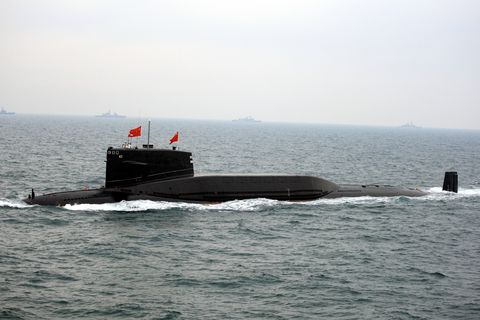China Is Building More Nuclear-Armed Submarines
Beijing believes nukes at sea are safer from surprise attack, but why does it want more of them?
By Kyle Mizokami GETTY IMAGES
GETTY IMAGESChina is building more nuclear-armed submarines to stay one step ahead of the U.S. and other adversaries. That’s the assessment from an arms control think tank, which believes China’s leaders are leaning toward basing their nuclear weapons at sea to prevent their destruction in a surprise attack. Although China will not likely built more nuclear weapons, it will likely build more submarines to conceal a larger and more effective second strike capability beneath the waves of the Pacific Ocean.
Unlike the United States and Russia, China has a very simple nuclear doctrine: China will not use nuclear weapons first. If you nuke China, China will nuke you back. That’s pretty much it.
China doesn’t need a whole lot to keep its nuclear policy credible. It has just 250 to 300 nuclear warheads, as opposed to America’s 6,450. As long as a handful of these bombs can reach their targets, and could incinerate cities such as Khabarovsk, Los Angeles, St. Petersburg, or Washington D.C., China’s adversaries are deterred.
In order to retaliate, however, China’s nuclear arsenal must be able to survive a surprise attack. Most of Beijing’s nukes are fitted to intercontinental ballistic missiles in protected silos and on mobile launchers. Just 48 of the warheads are fitted to submarine-launched ballistic missiles of the Type 094A, or Jin-class. China has four Jin submarines, each equipped with twelve launch silos for JL-2 ballistic missiles. This ensures that, between refuelings, drydock time, coming or going from patrol areas, the People’s Liberation Army Navy can keep at least one submarine on station, nuclear weapons-ready, at all times.
A new report from the Carnegie Center for Global Policy states that Beijing is seeking an unknown number of new nuclear submarines. The exact number is unknown, but the rule of thumb that a nuclear power needs four submarines to keep one on station suggests China would need to double its missile sub fleet from four to eight to see concrete improvements in the number of missiles it keeps at sea.
Where would the new warheads come from? As the article’s author Tong Zhao points out, you can’t simply take a missile off a DF-31 land-based missile and place it on a JL-2 submarine-based missile. China could remove the warhead and reuse the nuclear material for a new missile, or it may simply decide to process more nuclear material to create more warheads. China voluntarily stopped producing material when it had enough for an estimated 300 warheads, and manufacturing more warhead material would be a huge step back for arms control.
Why would China want to put more nukes at sea? That’s a good question. Something is making China’s policymakers insecure about their nuclear deterrent. China has concerns that U.S. ballistic missile defenses in Alaska, meant to protect the homeland from a handful of launches from countries such as North Korea and Iran, could be scaled up to stop a Chinese counterattack, giving the U.S. a freer hand in threatening China. More Chinese missiles would fend off such an attempt. The U.S. is also on the verge of building a hundred or more B-21 Raider bombers whose mission would be to hunt mobile missile launchers, where a substantial amount of China’s nukes reside. While the U.S. may have good reasons to build such systems, it should also be mindful of their second order effects.
Source: Carnegie-Tsinghua Center for Global Policy.
No comments:
Post a Comment